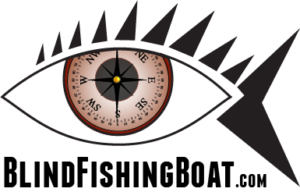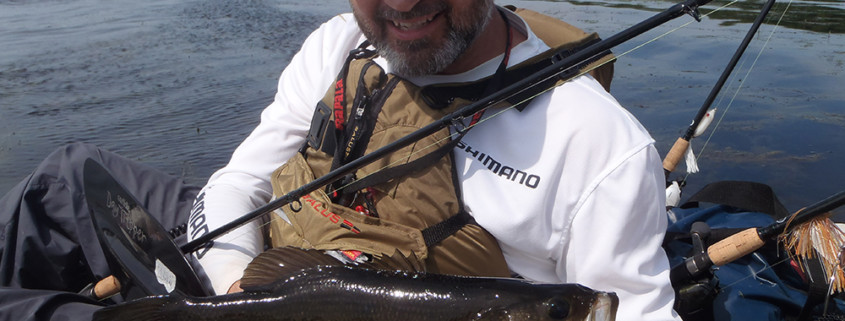Questions from a blind kayak enthusiast
Hi Lawrence,
This is XX from San Francisco. I found your website while I was searching about how to set up a boat that blind people can operate.
I am a blind ocean enthusiast. I frequently go fishing and kayaking in and around the SF Bay Area. For A while I have been thinking to set up a fishing kayak that I can paddle solo. I read about your porta boat set up and I am wondering what kind of sonar, compass, sensors, and GPS devices you used. How did you make them water proof? What techniques are you using to navigate in the ocean? Did you have any issues with the Coast Guard?
I would appreciate any suggestions. I have a tandem kayak. As soon as I figure out a way to paddle solo I’ll get a single fishing kayak and hit the water.
Thanks for your time.
Ahmet
Hello XX,
First off, I just want to say that I had the chance to visit San Francisco for the second time in 2015 and I think its one beautiful city. We visited for five days. My first visit to SF was in 2010 when I competed in the California International Blind Sailing Regatta and took first place. The Marin Sailing School for the blind run by Al Spector is one of the best.
Regarding fishing from a kayak, I’ve been doing it for some time now. From using ocean kayaks in the North Atlantic off the coast of Cape Bretton Nova Scotia, to sit-on-top paddle models on freshwater lakes, to my new favorite, the HobieCat Revolution equipped with the Mirage peddle drive system.
The Hobie kayak with the Mirage peddle system is my preferred choice for two reasons; one, the Mirage drive allows me to keep my hands free for fishing and operating electronics; and two, the hand-controlled rudder steering system allows me to make precise course corrections and to maintain a course heading. It’s also just an all-round fund kayak to fish from. However, if I was fishing along the Pacific coast, I might choose the wider more stable Outback or even one of the Pro Angler series from Hobie simply because it offers more stability. It’s all about trade-offs in the end, do you want something light and easily transported but maybe a bit less stable, or do you want the additional stability that a wider kayak can offer when getting bounced around in ocean swells and boat wakes.
As far as keeping electronics dry, get yourself one of Plano’s waterproof boxes. They come in many sizes, so once you know what you need to bring, look on their website and select the box that will best suit your needs. Make sure it says waterproof.
Talking Tackle Depth Whisperer makes a nice little talking depth sounder that comes with a transducer and works quite well. When I’m ice fishing or on one of my boats, I use a Lowrance fish finder and set the fish alert audible feature to on. It emits clicks when baitfish are encountered below, and different beep configurations to indicate the various sizes of gamefish. Between the Depth Talker and the Lowrance, I’m quite well informed. In fact, when I use them together, I simply connect the Depth Talker directly to the Lowrance and dispense with the need to use a second transducer.
Scotty Plastics makes a bunch of handy fishing and paddle sport accessories that you should check out. I use their paddle and rod leashes so even if I drop something overboard, it isn’t lost. Leash it or lose it. They also make lights, safety kits, rod holders, tracks for use in attaching rod holders and such and much more.
As far as sensors go, I wouldn’t bother. With salt water being so corrosive, it wouldn’t last. Besides, what are you going to bump in to out there on the ocean anyway.
HumanWare makes the Trekker Breeze talking GPS which is about the most ruggedized system for the blind I’ve ever got my hands on, and it’s pretty tough. You can easily make waypoints, and then select these waypoints later to navigate “as the crow flies”. It gives you audible announcements that allow you to keep on track. For more precise heading tracking, I use a supplemental MaxPac audible compass that has one button that allows you to activate when you are on course, then emits high and low frequency beeps to let you know if you’re veering off course. You can always use an iPhone as well for cardinal compass directions, but I have yet to discover an app that offers audible waypoint recording and navigation with the same blind-friendly usability that the Trekker Breeze offers. Columbus is a company that makes a talking compass, but it only offers very basic information and is better suited for hiking than on-water-navigation.
One of the best systems for navigating on the water and avoiding collisions when out with friends is to attach a small bell on their kayak somewhere. Fishing stores often sell small bells for tips of ice fishing rods. Clip one of these to the tip of their rods held in their rod holders, or to their marker flag so it gets the movement of the kayak to activate the bell, but is positioned further away from your friend as not to drive them nuts. I’m told that after a while they stop noticing the bell as it becomes white noise like the bells on sailboat masts.
Navigating really comes down to paying attention. The feel of the wind on your cheek, the movement of the boat over the waves, the sound of waves rolling up on shore, cars crossing bridges or travelling along coastal highways, etc., all offer clues to where you are and which way you are pointing. Remember, navigating over water in a straight line is not nearly as easy as walking along a sidewalk. There are no grassy edges or curbs to rely on. It’s very easy to veer off course so you need to work hard on developing an entirely new orientation skill as someone without sight. Nothing you learned about walking with a guide dog or white stick applies, and there is no land-based physical sensation that is repeated on the water. Walking in a straight line without the use of aids involves a lot of muscle memory, and this is of no use to you on the water. Paddling or steering in a straight line on the water involves the feel of the current and waves transmitted through the seat of the boat, and the feel of the sun and wind on your face. If it’s raining hard or blowing on shore, there is no sound source that you can depend on. If the water is flat calm and the wind is down, you can often hear sounds coming from shore that can be used for navigation. Like I said though, wind just blows sound away while at the same time generating new sounds as water and waves interact with the hull of your boat.
Always good to have two systems of navigation that you can depend on. Then too, make sure someone on shore knows where and when you set out on to the water. Keeping a means of communication with you such as a cellphone or two-way radio is a good idea, or when on the coast, a VHF radio. For the later, you require a VHF radio operator’s certificate.
I don’t blame you for wanting to get out of a double or tandem kayak. Nothing is more frustrating than two people trying to fish out of a tandem and continually crossing rods. I first started to use a single sea kayak on the Atlantic. More than once I heard a voice far in the distance yelling for me to turn around. I had no technology at the time to depend on, so had to learn quickly how to navigate the same way maritime fishers did for hundreds of years off the coast of Newfoundland when fog set in and they had to use all their other non-visual senses to make their way back into their well protected harbors surrounded by rocks. You can smell land when you are getting close, and the waves feel different, sharper and closer together. I spent a number of summers fishing with these old salts to earn money to put myself through university.
Unlike the maritime fishers of old, you want to get yourself a comfortable personal flotation device (PFD). Salus Marine makes a PFD specifically for anglers who kayak. It’s higher up on the back so it doesn’t interfere with the seat back. None of the fishers I fished with on the Atlantic could even swim, and none carried flotation devices aboard their boats. Their theory was that if the boat went down, you would only live a short time in the cold Atlantic water anyway, so why pro-long the struggle. Now, with emergency beacons and radios, you stand at least a chance of being rescued before hypothermia kicks in. You have about an hour, but only 20 minutes of that counts for actual time that you can use your arms and legs to swim. After that, you are just trying to maintain consciousness. The pacific up near you is cold too, so play safe.
Remember, kayaks have no built in emergency flotation. They are prone to sinking fast once water finds a way in. One way to avoid having your investment disappear from beneath you, is to stuff four pool noodles inside the hull.
I hope this answers your questions. As far as the coastguard goes, you will need to sort that out yourself. Here in Canada there are no rules stopping a blind person from kayaking or canoeing. If you want to operate anything with a motor, including kayaks fitted up with electric motors like the Torqeedo, you need a pleasure boat operator’s certificate, which blind people are permitted to acquire in Canada.
All the best,
Lawrence






Comments are closed.